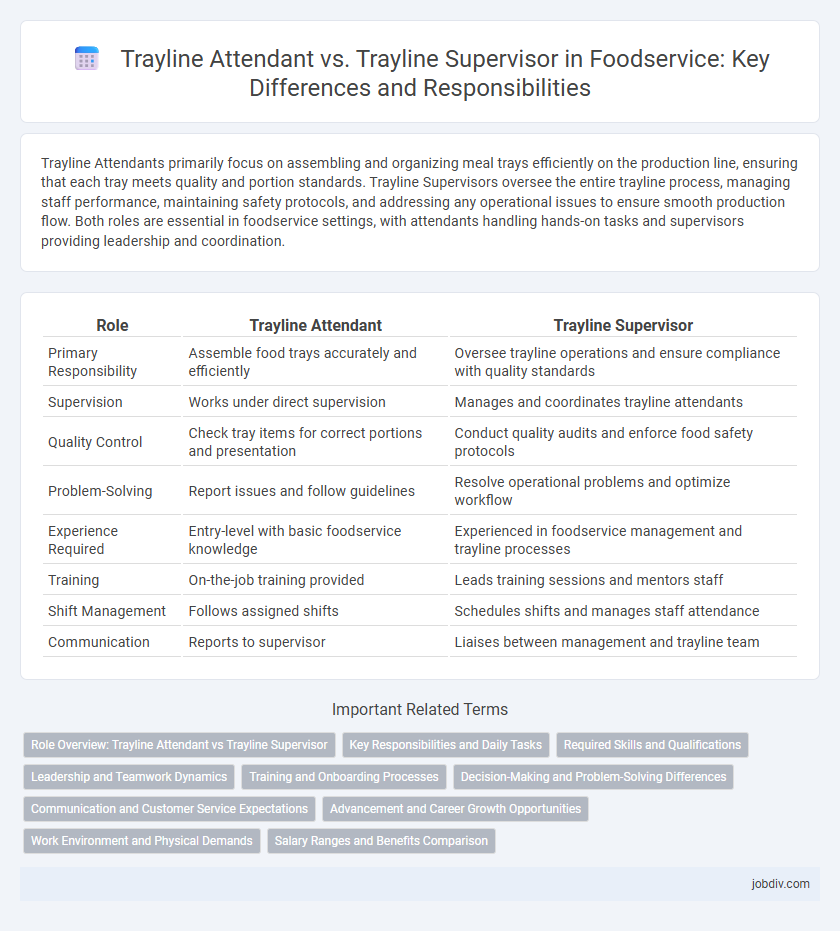Trayline Attendants primarily focus on assembling and organizing meal trays efficiently on the production line, ensuring that each tray meets quality and portion standards. Trayline Supervisors oversee the entire trayline process, managing staff performance, maintaining safety protocols, and addressing any operational issues to ensure smooth production flow. Both roles are essential in foodservice settings, with attendants handling hands-on tasks and supervisors providing leadership and coordination.
Table of Comparison
| Role | Trayline Attendant | Trayline Supervisor |
|---|---|---|
| Primary Responsibility | Assemble food trays accurately and efficiently | Oversee trayline operations and ensure compliance with quality standards |
| Supervision | Works under direct supervision | Manages and coordinates trayline attendants |
| Quality Control | Check tray items for correct portions and presentation | Conduct quality audits and enforce food safety protocols |
| Problem-Solving | Report issues and follow guidelines | Resolve operational problems and optimize workflow |
| Experience Required | Entry-level with basic foodservice knowledge | Experienced in foodservice management and trayline processes |
| Training | On-the-job training provided | Leads training sessions and mentors staff |
| Shift Management | Follows assigned shifts | Schedules shifts and manages staff attendance |
| Communication | Reports to supervisor | Liaises between management and trayline team |
Role Overview: Trayline Attendant vs Trayline Supervisor
Trayline Attendants are responsible for efficiently assembling and organizing trays with food items, ensuring portion control and food safety standards on the line. Trayline Supervisors oversee attendants, manage workflow, maintain quality control, and address any operational issues to optimize productivity in the foodservice environment. Both roles are critical for maintaining smooth tray production, but Supervisors focus on leadership and quality assurance while Attendants execute the assembly process.
Key Responsibilities and Daily Tasks
Trayline Attendants primarily focus on assembling and organizing meal components efficiently on trays to meet food safety and presentation standards. Trayline Supervisors oversee the entire tray assembly process, ensuring compliance with quality control, managing staff schedules, and addressing any production issues in real-time. Both roles require adherence to hygiene protocols, but Supervisors have added responsibilities related to team leadership and operational oversight.
Required Skills and Qualifications
Trayline Attendants require strong organizational skills, attention to detail, and the ability to work efficiently in fast-paced environments to ensure timely and accurate tray assembly. Trayline Supervisors need advanced leadership abilities, including team management, conflict resolution, and extensive knowledge of food safety regulations to oversee operations and maintain productivity standards. Both roles demand excellent communication skills and familiarity with compliance protocols in the foodservice industry.
Leadership and Teamwork Dynamics
Trayline Supervisors oversee the efficiency and quality control of foodservice operations, providing strategic leadership and coordinating team efforts to meet production targets. Trayline Attendants execute daily tray assembly tasks, collaborating closely with peers to maintain consistent workflow and ensure accuracy. Effective teamwork between supervisors and attendants enhances communication, fosters accountability, and drives operational excellence in busy foodservice environments.
Training and Onboarding Processes
Trayline Attendants undergo hands-on training that emphasizes efficient tray assembly, portion control, and adherence to sanitation protocols, ensuring consistent foodservice delivery. Trayline Supervisors receive advanced onboarding that includes leadership development, workflow optimization, and quality assurance practices to manage team performance effectively. Structured training programs for both roles prioritize operational excellence and compliance with food safety standards.
Decision-Making and Problem-Solving Differences
Trayline Attendants primarily execute routine tasks and follow established procedures, making decisions within defined guidelines to maintain smooth trayline operations. Trayline Supervisors oversee the entire trayline process, using advanced problem-solving skills to address unexpected issues, optimize workflow, and make strategic decisions that improve efficiency and quality. Supervisors also analyze data and coordinate with management to implement process improvements, while attendants focus on task accuracy and consistency.
Communication and Customer Service Expectations
Trayline Attendants must maintain clear, concise communication with kitchen staff and customers to ensure efficient service flow and promptly address customer needs. Trayline Supervisors oversee the communication dynamics between attendants and management, ensuring that customer service protocols are consistently followed and issues are resolved effectively. Both roles require strong interpersonal skills, but Supervisors carry the added responsibility of training, performance feedback, and maintaining high service standards.
Advancement and Career Growth Opportunities
Trayline Attendants build foundational skills in food handling and assembly, positioning themselves for promotion to supervisory roles through demonstrated reliability and efficiency. Trayline Supervisors oversee daily operations, manage team performance, and implement quality control, gaining leadership experience essential for advancing to management positions in foodservice operations. Career growth from attendant to supervisor enhances expertise in production workflows, team coordination, and operational oversight within high-volume trayline environments.
Work Environment and Physical Demands
Trayline Attendants operate in fast-paced foodservice environments requiring constant standing, repetitive motions, and manual tray handling to maintain efficient meal assembly lines. Trayline Supervisors work in the same setting but have additional responsibilities, including overseeing staff performance, ensuring compliance with safety standards, and managing workflow under pressure. Both roles demand physical stamina, but supervisors also require strong leadership skills to maintain productivity in high-volume foodservice operations.
Salary Ranges and Benefits Comparison
Trayline Attendants typically earn between $12 and $16 per hour, with benefits including basic healthcare and employee meal discounts, while Trayline Supervisors command higher salaries ranging from $18 to $24 per hour coupled with enhanced benefits such as comprehensive health insurance, paid time off, and leadership bonuses. Supervisory roles often include additional perks like retirement plans and professional development opportunities that are less common for attendant positions. Salary growth potential is greater for Trayline Supervisors due to increased responsibilities and managerial duties within foodservice operations.
Trayline Attendant vs Trayline Supervisor Infographic

 jobdiv.com
jobdiv.com